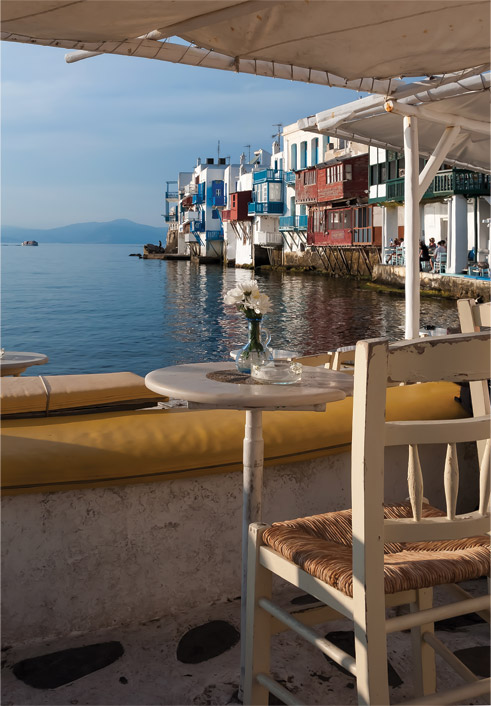




MYKONOS SIGHTSEEING
Towns & Sights
Mykonos is considered as the most cosmopolitan spot in Greece, with lots of attractions, such as the amazing beaches, the picturesque villages, the vivid nightlife, the numerous churches and museums.
Ano Mera Village
Ano Mera is located 8 km. away from Mykonos Town, in the middle of the island and is the most populated village of the island, consisted by several scattered settlements around the monastery and the Panagia Tourliani church which constitute the center of the village. This pure cycladian architecture monastery was built in the 16th century and it was restructured in 1767 by impressive elements, worth to see. On the hill opposite Ano Mera village, the Paleokastro Monastery stands where there are remains of the Byzantine Castle and its fortress, as well as graves of the ancient Geometric period of Greece.Ftelia & Panormos ancient settlement
In between Panormos and Ftelia beach, archaeologists excavated a 7,000-year-old settlement with well-preserved remains of public buildings and a rare example of the Neolithic goldsmith´s art, including pottery, obsidian blades, terracotta figurines and the fired clay model of a boat, as well as an extremely rare circular gold pendant with a hole in the middle for suspension.Little Venice-Mykonos Town
Little Venice is located on the western part of the town where it meets the sea. The buildings have been constructed right on the sea"s edge with their balconies barely meeting the water. During the 16th and 17th century pirating was very common and it is believed that this area was used for the necessary quick loading and unloading of goods.Mykonos Lighthouse
The Lighthouse of Mykonos, called “Armenistis†is located on the northeastern part of the island at about 7 km away from Mykonos Town . Getting there is very easy, by following the signs to Fanari/Agios Stefanos. Armenistis Lightouse is located on a beautiful place with amazing view of Tinos island and the boats arriving or leaving from Mykonos. The mechanism of the Lighthouse’s first lamp is exposed at the Aegean Naval Museum in Mykonos Town(Chora)Mykonos Town
Mykonos Town, called Chora, is definitely one of the nicest and most charming old towns of the Greek islands, with endless small streets, shops, windmills, churches, terraces and whitewashed houses. The perfect place to wonder around with lots of bars, restaurants, shops and secret spots with amazing views of the Aegean Sea.Mykonos Town Hall
The Town Hall is an impressive two-storied building, built in 1780, hosting all local and international authorities since then. The building itself and its surrounding buildings, are worth to visit, as they are an architectual landmark of the older ages.The Windmills of Mykonos Town
From as early as the 16th century one of the most recognized landmarks of Mykonos Island have been the windmills. Due to it"s geographic position, Mykonos was situated on major sea trade-route which at one time joined Venice, the gateway of Europe, to Asia. The need to refine grain and compact it for transport combined with an ample year round supply of wind made Mykonos the perfect location. Easy access to the harbor was necessary so most of the island"s mills were positioned in or around the main port with the highest concentration covering the entire western portion of town. With the coming of industrialization the windmills importance began to decline.Aegean Maritime Museum
The Aegean Maritime Museum is a non-profit institution founded in 1983. The goal of the museum is the preservation, promotion and study of the Greek maritime history and tradition, and in particular the evolution and activities of the merchant ship, chiefly in the historic region of the Aegean Sea. The Aegean Maritime Museum is housed in a traditional Mykonian building of the 19th century located at the centre of the Town of Mykonos, in the area known as Tria Pigadia. The building was the home of the legendary Master of the merchant ship "Enosis", Nikolaos Sourmelis, who assisted the Cretans during their war of independence from the Ottoman Empire. The museum"s exhibits include models of ships from the pre-Minoan period down to the beginning of the twentieth century, historical shipping documents, rare engravings and maps, ancient artifacts, navigational instruments, equipment and tools, as well as a collection of rare coins with nautical subjects from the fifth century BC to the fifth century AD.In the museum"s garden lie reproductions of ancient marble gravestones from the islands of Myconos and Delos, dealing with shipwrecks and sailors who were lost at sea.Archaeological Museum of Mykonos
The Archaeological Museum of Mykonos was built in 1902 and the exhibition includes a large number of vases, ranging from the prehistoric to the late Hellenistic period (25th-1st century B.C.), grave statues, steal and funerary urns, pottery, jewelry, amphora, clay figurines and little archaic objects.Mykonian Folklore museum
The museum was founded May 1958 and is situated at Castro, in a 18th century building. In there, are exposed museum articles sorted by subject. Keys and locks collections, handwoven tapestries, painted plates, old weights and measures, traditional. Cycladic sculptures and lighting devices ranging from the ancient oil to the kerosene lamp. Obsedian tools and weapons representing the interior of a 19th century middle class drawing room. A 19th century bedroom. A 19th century kitchen.The Agricultural Museum
is situated at Ano Mili (Up Windmills) in the town of Mykonos. It is a branch of the Folklore Museum and hosts installations for the processing agricultural products on the island before industrialization. The large "Bonis" -after the captain- windmill, which dates since 16th century is a listed building, a traditional threshing-floor and a village style oven, the wine-press, a water wheel, a stone water tank, dovecote, pigsty, the miller"s house and two little twin churches. There is also a collection of old agricultural tools and machinery.Churches of Mykonos
A characteristic feature of the mykonian landscape is the plethora of votive chapels. After the World War II it was said that these chapels were as numerous as days of the year. The locals continue the tradition of building chapels as an act of devotion. It is estimated that the number of chapels today is close to 800 (which is actually one per local family). Some chapels are very old and have been designated as historical monuments by the Ministry of Culture, but the majority of them have been built during the last two centuries. These charming simple constructions, with a (usually) red arched roof, ornament the mykonian countryside. They play a vital role in the ilies" spiritual and social life. Let alone in Chora it is said to be about 60 churches!Paraportiani Church
This is the most popular and most photographed of the 400 churches on the whole island of Mykonos. What makes this church so unique is its construction which is an assymetrical conglomeration of 4 churches into one. Notice the 4 different architectural styles mixing Byzantine, vernacular, traditional and western style. The church dates back to the middle of the 15th century A.D. The name comes from the word "Porta" = Door and Para=secondary as it was build right next to the entrance of the Medieval castle in Mykonos town , which unfortunately has been completely destroyed. Building of great Architectural value, it consists of 4 ground floor temples and one of the first floor, which is the main church. The churches around it (Aghios Sozontas, Aghii Anargyri, Aghia Anastasia, and Aghios Efstathios) comprise the whole of the church of ParaportianiΑριθμός γνωστοποίησης: 1295798


